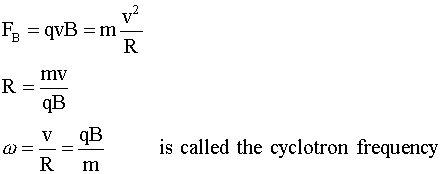|
Phys 4, Section
2
Feb 18, 2002
Motion of Charged Particles in a B-Field
Since magnetic force FB is perpendicular to direction of
motion v, no work is done and no change in magnitude of velocity vector
is possible, only change in direction. If the force and velocity are constant
and at right angles, the particle will go in a circle of radius R, and the
magnetic force FB will act as a centripetal force FC:

Velocity Selector
If a moving charged particle is placed between crossed E and B fields, it
will feel two forces, electric and magnetic. If the fields are properly
oriented, there is a unique velocity at which the forces will cancel and the
particle will move at constant speed in a straight line.

Magnetic Force on a Current-Carrying Conductor
Let density of free charges moving with drift velocity vd in a
conductor be n; then a segment of length L and cross-section A
will have nAL charges. The total force on all these charges due to a B-field
oriented perpendicular to the conductor is
J = nqvd
and JA = I, so
F = ILB
In the more general case where the conductor and B-field are not
perpendicular to each other,
F = ILB
sin φ
F = IL × B
where φ is the angle between conductor and
field
Force and Torque on a Current Loop
A rectangular loop of dimensions a and b, carrying a current I,
and free to rotate about a central axis passing through the midpoints of b
on opposite sides plane of the loop is placed in a uniform B-field which is
perpendicular to the loop axis. Calculating the force on each side of the loop
shows that the forces on opposite sides of the loop cancel, so there is no net
force. However, since the loop can rotate about its axis, torques must be
considered.
τ =
2F(b/2)sin φ = IBab sin φ = IAB sin φ
if the product of the loop area A and the current I around the loop is called
the magnetic dipole moment μ, then the torque
can be described as
τ
= μ × B
A special case is that of a solenoid, which consists of many (N) closely
wound loops. The total torque on all the loops is given by
τ = NIAB
sin φ
where φ is the angle between the solenoid
axis and the B-field.
Last modified on February 27, 2002
|